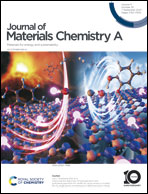Electrochemical synthesis of hydrogen peroxide on BiNiOx−4 and in situ disinfection†
Abstract
Hydrogen peroxide (H2O2) is a widely used chemical, and the synthesis of this compound via two-electron oxygen reduction reaction (2e− ORR) electrochemistry has recently become a more attractive alternative to traditional anthraquinone processes, garnering increasing attention. Currently, the controlled preparation of 2e− ORR electrocatalysts is a challenge, and the in situ disinfection of H2O2 is an urgent research issue that merits further investigation. Here, BiNiOx−4 catalysts with various crystalline surfaces can be synthesized by modulating the Bi content, and applied to the electrocatalytic production of H2O2. As a result, the selectivity reached 93.2% at 0.4 VRHE under alkaline conditions. Furthermore, neither the current density nor the H2O2 selectivity decreased after continuous testing for more than 90 h, indicating the good stability of BiNiOx−4 in practical applications. In contrast, the homemade flow-cell was able to produce a H2O2 concentration of 223 mmol L−1 in 2 h under neutral conditions, surpassing the performance of other catalysts reported under similar conditions. DFT calculations demonstrated that the excellent performance of the catalyst was due to the synergistic effect of Bi and Ni in BiNiOx−4. The in situ generated H2O2 was found to achieve a complete elimination of bacteria within approximately 5 minutes. This work offers a promising outlook for 2e− ORR electrocatalytic production and in situ utilization of H2O2.



 Please wait while we load your content...
Please wait while we load your content...